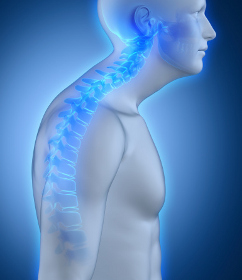Bracing, medication, exercises, and surgery are the main treatment measures for kyphosis. The following Buzzle article throws light on each one of these treatment options in detail.

Kyphosis is defined as the abnormal condition of the spine, wherein, it curves more outwards, leading to a humped back. It is known by various other names such as hunchback, Scheuermann's disease, postural kyphosis, etc. It often results in loss of height and hinder with breathing. It is caused by a number of factors, such as, osteoporosis, ankylosing spondylitis, degenerative arthritis of the spine, connective tissue disorders, polio, cerebral palsy, spina bifida, tuberculosis and other infections, and cancer or benign tumors. The treatment depends upon the underlying cause. However, it is generally treated with braces, medications, physical therapy, and surgery only when required.
Treatment Methods
Braces
A brace is generally recommended for teenagers, who are still growing and are suffering from moderate to serious kyphosis. The brace, when worn regularly and as prescribed, slows down or prevents further progression of the condition. It may also correct the curvature to some extent. Patients, who wear braces, need to avoid certain things like, playing any rigorous sport and doing strenuous physical work. In some cases, adults may also be prescribed braces. The goal of braces here, is to reduce the intensity of pain.
Medications
Pain is one of the common symptoms of kyphosis. The doctor may prescribe pain killers in accordance with the intensity of pain that you experience. Generally, doctors start with over-the-counter (OTC) pain killers, like, acetaminophen and NSAIDs (non-steroidal anti-inflammatory drugs) such as Advil, Aleve, etc. If OTC pain killers fail to provide relief, your doctor will give you stronger medications to ease your condition. In case, tumor is the reason behind the condition, a medical practitioner may prescribe chemotherapy drugs as well.
Exercises
There are certain exercises that are designed specifically to relieve symptoms of kyphosis. If your doctor feels the need of such exercises for postural or cervical kyphosis cure, he may refer you to a physical therapy professional. You need to perform the exercises properly and as directed by the physical therapist. Be very careful with the number of repetitions for each exercise. To be on the safer side, perform them under the supervision of an expert.
Surgery
Surgery is considered to be an option for treatment when the condition is congenital, caused by a cancerous growth, causes sharp pain, and involves some neurological or extreme deformities, which cannot be cured with non-surgical methods like, bracing and physical therapy. Surgery always involves fusion and attachment of instruments to the spine. The new arrangement stabilizes the spine by correcting the deformity. The surgery, usually, leaves no chance of recurrence of the condition. The fusion done during surgery, generally, employs a piece of the pelvic bone to connect two vertebrae together. It prevents the curvature from progressing. Instruments like rods, hooks, screws, and wires are often used to make the spine stable and keep the vertebrae in place as they fuse together. Surgical procedure may give rise to some complications such as, infection, nerve damage, bleeding, arthritis, and disk degeneration. In case of the occurrence of any of these given negative effects, another surgery may be needed for rectification.
In addition to prescriptions and recommendations of your doctor, you should take care of your diet. Follow a healthy diet, which will strengthen your natural ability to recuperate fast, and thus, will help you get well soon.


 Kyphosis is defined as the abnormal condition of the spine, wherein, it curves more outwards, leading to a humped back. It is known by various other names such as hunchback, Scheuermann's disease, postural kyphosis, etc. It often results in loss of height and hinder with breathing. It is caused by a number of factors, such as, osteoporosis, ankylosing spondylitis, degenerative arthritis of the spine, connective tissue disorders, polio, cerebral palsy, spina bifida, tuberculosis and other infections, and cancer or benign tumors. The treatment depends upon the underlying cause. However, it is generally treated with braces, medications, physical therapy, and surgery only when required.
Kyphosis is defined as the abnormal condition of the spine, wherein, it curves more outwards, leading to a humped back. It is known by various other names such as hunchback, Scheuermann's disease, postural kyphosis, etc. It often results in loss of height and hinder with breathing. It is caused by a number of factors, such as, osteoporosis, ankylosing spondylitis, degenerative arthritis of the spine, connective tissue disorders, polio, cerebral palsy, spina bifida, tuberculosis and other infections, and cancer or benign tumors. The treatment depends upon the underlying cause. However, it is generally treated with braces, medications, physical therapy, and surgery only when required.